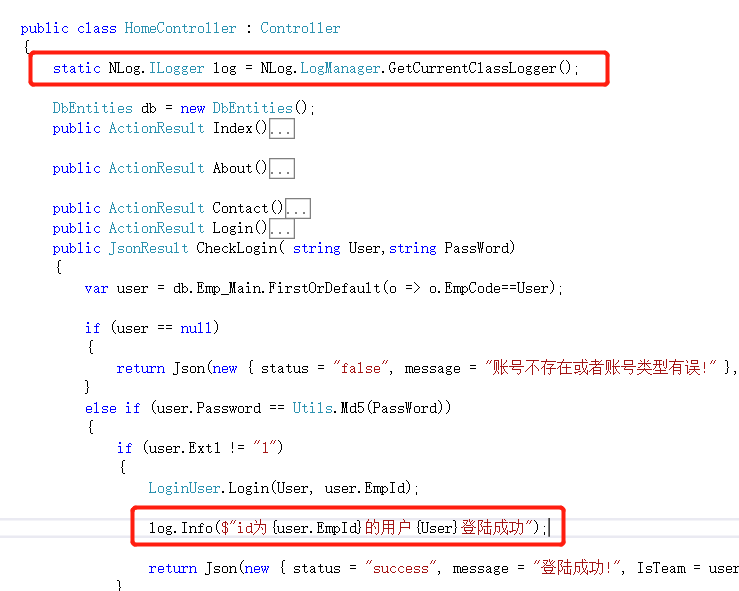nlog的简单使用
1.nuget 安装 nlog
2.根目录下(与config同级)添加 NLog.config 文件
<?xml version="1.0" encoding="utf-8" ?>
<nlog xmlns="http://www.nlog-project.org/schemas/NLog.xsd"
xmlns:xsi="http://www.w3.org/2001/XMLSchema-instance"
internalLogFile="C:\Temp\NLog.Internal.txt" >
<variable name="logLayout"
value="Logger:${logger}${newline}Date:${longdate} Level:${uppercase:${level}}${newline}Message:${message} ${newline}${onexception:Exception:${exception:format=toString}${newline}}" />
<targets>
<target name="asyncFile" xsi:type="AsyncWrapper">
<target name="log_file" xsi:type="File"
fileName="${basedir}/Logs/${shortdate}/${shortdate}.txt"
layout="${logLayout}"
archiveFileName="${basedir}/archives/${shortdate}-{#####}.txt"
archiveAboveSize="102400"
archiveNumbering="Sequence"
concurrentWrites="false"
keepFileOpen="true"
encoding="utf-8"
openFileCacheTimeout="30"/>
</target>
</targets>
<rules>
<logger name="*" minlevel="Info" writeTo="asyncFile" />
</rules>
</nlog>
3.代码中使用





【推荐】国内首个AI IDE,深度理解中文开发场景,立即下载体验Trae
【推荐】编程新体验,更懂你的AI,立即体验豆包MarsCode编程助手
【推荐】抖音旗下AI助手豆包,你的智能百科全书,全免费不限次数
【推荐】轻量又高性能的 SSH 工具 IShell:AI 加持,快人一步
· .NET Core 中如何实现缓存的预热?
· 从 HTTP 原因短语缺失研究 HTTP/2 和 HTTP/3 的设计差异
· AI与.NET技术实操系列:向量存储与相似性搜索在 .NET 中的实现
· 基于Microsoft.Extensions.AI核心库实现RAG应用
· Linux系列:如何用heaptrack跟踪.NET程序的非托管内存泄露
· TypeScript + Deepseek 打造卜卦网站:技术与玄学的结合
· 阿里巴巴 QwQ-32B真的超越了 DeepSeek R-1吗?
· 【译】Visual Studio 中新的强大生产力特性
· 10年+ .NET Coder 心语 ── 封装的思维:从隐藏、稳定开始理解其本质意义
· 【设计模式】告别冗长if-else语句:使用策略模式优化代码结构